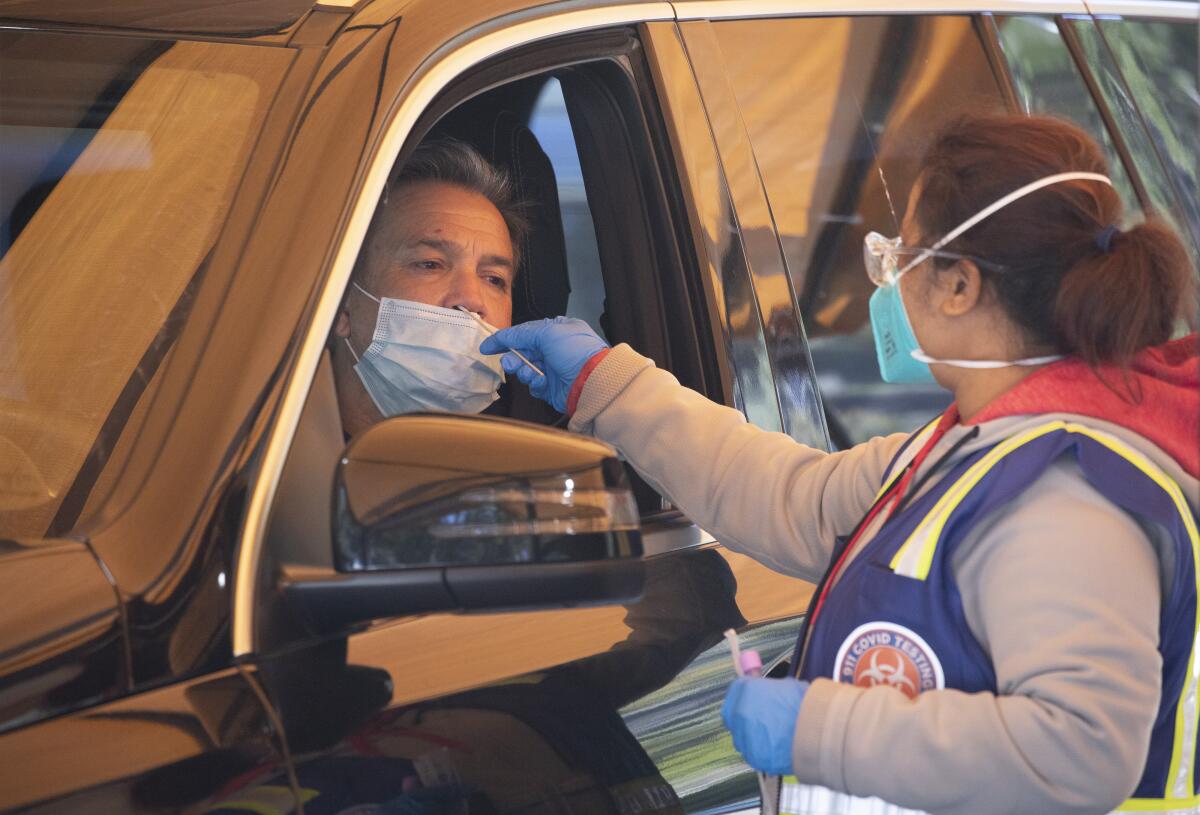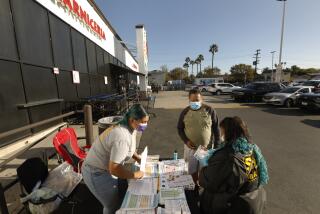L.A. County sees 10-month high in COVID death rate

Los Angeles County saw an average of 40 coronavirus deaths a day over the past week, the highest such rate in nearly 10 months, a sign that the prolific Omicron variant may be deadlier than many initially believed.
The countyâs daily COVID-19 death rate has doubled in just a week, officials said. According to a Times analysis, the last time average daily deaths has been this high was for the seven-day period that ended on March 28, 2021.
The daily death tally in the county has climbed dramatically in recent days. On Tuesday, 15 deaths were reported; Wednesday, 39; Thursday, 45; Friday, 48; Saturday, 66, the highest number in more than nine months; and Sunday, 53.
âAs deaths often lag behind surges in cases and hospitalizations, sadly, the increase in deaths does not come as a surprise, and tragically, we are prepared for even higher number of deaths in the coming weeks,â said L.A. County Public Health Director Barbara Ferrer.
The latest average daily death figure remains well below that of the peak of last winter, when very few people were vaccinated because of limited supply. At that time, L.A. County was averaging about 240 COVID-19 deaths a day.
Much has been said about Omicron being less likely to cause severe illness and death than earlier variants. Around New Yearâs Eve, headlines emerged about South Africa heading out of its Omicron surge with relatively few deaths.
Experts have pointed out that Omicron in adults is less likely to infect the lungs, which can result in difficulty breathing, while being more contagious in the upper respiratory system. There are also fewer critically ill COVID-19 patients in the county compared to last winter: the number of coronavirus patients in the intensive care unit is just 36% of the peak of last winterâs surge, when there were 1,731.
But some experts warn that the U.S., with a demographically older population, could experience a deadlier Omicron wave than South Africa. And in L.A. County, data are emerging that this winterâs surge is resulting in more critically ill patients than seen during last summerâs wave.
Just in the last week, L.A. Countyâs number of ICU patients with COVID-19 soared past the peak of the earlier Delta surge. In late August, the number of coronavirus ICU patients peaked at 463; L.A. County surpassed that number on Jan. 9, and as of Saturday, there were 622, a figure that continues to climb.
Some experts have warned against underplaying how severely ill some people will get when infected with the coronavirus this winter, particularly if they remain unvaccinated, havenât received their booster shot, are older or have underlying medical conditions.
Dr. Ashish Jha, dean of the Brown University School of Public Health, tweeted that he recently cared for elderly patients hospitalized for COVID-19 who hadnât received their booster and said they didnât realize they needed it or were eligible. Jha also treated an unvaccinated person who couldnât believe he had to be hospitalized after being reinfected with the coronavirus; he had previously survived COVID-19 last spring, also with a hospital stay.
âHe couldnât believe he had COVID again,â Jha tweeted. He âhad been told he had life-long immunity. The misinformation on infection-induced immunity is costing lives.â
Health officials warn that early estimates of Omicronâs mildness are still subject to change as more data emerge.
Before Omicron started spreading in L.A. County, in early November, nearly 75% of coronavirus-positive patients were being treated for illness related to COVID-19, while the remainder were in the hospital for reasons incidental to their coronavirus infection.
L.A. County officials initially estimated that, as Omicron spread, only 46% of coronavirus-positive patients admitted around the Christmas holidays required hospital care for reasons related to their viral infection. But late last week, based on more recent data, officials said a greater share of coronavirus-positive patients actually needed care for a COVID-19-related illness: 58%.
Dr. Eric Topol, director of the Scripps Research Translational Institute in La Jolla, said last week he thinks there are more coronavirus-positive people in the hospital being treated âforâ COVID-19, rather than being in the hospital âwithâ a coronavirus infection.
âWe have this maybe warped view about how mild, or milder, Omicron is when it clearly can kill and put a lot of people in the hospital,â Topol said during an online discussion Thursday with Dr. Robert Wachter, chair of UC San Franciscoâs Department of Medicine. âToo many have tried to minimize the hospitalizations ... and I think we are grossly overestimating the âwithâ rather than the âforâ COVID.â
Recently the director of the Centers for Disease Control and Prevention, Dr. Rochelle Walensky, said she suspected that most recent COVID-19 deaths are a result of people infected with the Delta variant rather than Omicron.
But on Saturday, the L.A. County Department of Public Health said that âthe majority of deaths reported this week are associated with individuals who became infected after Dec. 20, when Omicron was circulating widely,â suggesting that Omicron may end up playing a bigger role in COVID-19 deaths than initially believed.
While early studies have shown that, with more recent COVID-19 patients, thereâs less of a need for an artificial oxygen supply or for them to be placed on a mechanical ventilator, âthatâs not universally the case,â Dr. Paul Simon, chief science officer for the L.A. County Department of Public Health, said in an interview Friday.
Simon said about half the recent deaths were among people diagnosed with a coronavirus infection this month, when Omicron had become the dominant variant. âSo itâs not that Omicron is completely harmless. It can cause severe disease in some people,â he said.
Unvaccinated people have the highest risk of being infected and becoming severely ill, but itâs also possible some vaccinated people, especially those who are elderly and who are vulnerable to COVID-19 complications, will get breakthrough infections and become severely ill.
The coming weeks will be âa bad time to be hospitalized,â said UC San Francisco infectious-diseases expert Dr. Peter Chin-Hong, âwhen California will probably already be in the middle of being bursted at the seams for increased hospitalization.â
Meanwhile, Los Angeles County is continuing to report a high number of new daily coronavirus cases. On Sunday, 43,883 new coronavirus cases were reported.
For the seven-day period that ended Sunday, L.A. County is now averaging about 41,000 coronavirus cases a day, a huge spike compared to the prior week, when the county reported about 32,000 cases a day. Last winter, L.A. County peaked at 16,000 cases a day.
New coronavirus cases among nursing home residents is also climbing, concerning officials, which analyzed the numbers for the seven-day period that ended Jan. 2 and compared them to the prior week.
As of Jan. 8, there were 137 active coronavirus outbreaks in skilled nursing facilities, which officials said was an 88% increase from the prior week. While 91% of nursing home residents and 97% of staff have received vaccinations, only 54% of staff have received a booster, while 85% of residents have done so.
Officials say they believe the booster rate among staff will rise following a requirement issued on Dec. 23 that workers in hospitals and skilled nursing facilities get a booster shot; the deadline to get one arrives Feb. 1.
The number of coronavirus-positive people who are hospitalized continued to climb. According to data released Sunday, as of Saturday, there were 4,507 coronavirus-positive people in L.A. Countyâs hospitals, a quintupling since Christmas, when there were 904 coronavirus-positive patients.
The number of coronavirus-positive patients admitted in L.A. Countyâs hospitals remain well below the peak of last winter, when 8,098 were in hospitals on Jan. 5, 2021.
More to Read
Sign up for Essential California
The most important California stories and recommendations in your inbox every morning.
You may occasionally receive promotional content from the Los Angeles Times.













